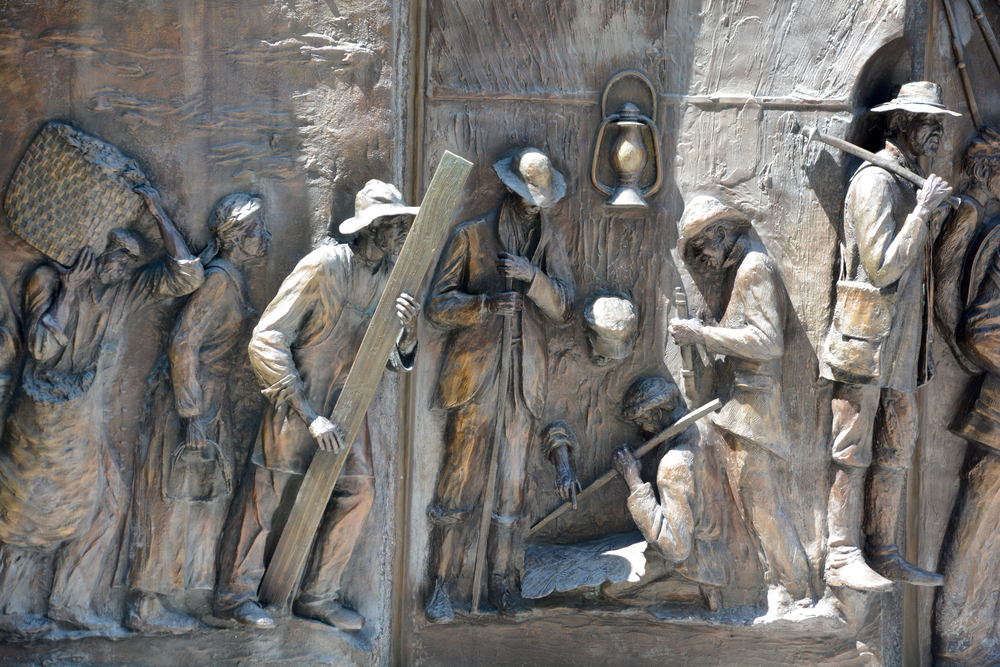The strength of American narratives is such that contrarian perspectives usually remain muted, especially on the outside. Central to these narratives is the projection of a linear view of history beginning with the Declaration of Independence in 1776, a revolutionary war for freedom from Britain and the adoption of a Constitution to “secure the Blessings of Liberty” for the people. This optimistic view progresses over the 19th and 20th centuries through a bloody Civil War to end slavery, an intervention in Europe to defeat fascism and Nazism and the progressive expansion of economic prosperity and civil rights in the United States of America itself. All this makes liberty and freedom central motifs of US history.
Are there alternative readings of this history? A series of articles in the second half of 2019 in The New York Times attempted one and in the process reopened the question of how history can be read from entirely different perspectives, suggesting that much, therefore, depends on the questions asked.
The New York Times grouped this series under the title, “The 1619 Project”. In this perspective, US history begins not in 1776 with its Declaration of Independence and war with Britain but in 1619 when the first batch of African slaves arrived in Virginia. And since then it is slavery and racism that would form the central axis of US history. Slavery then was not just the country’s original sin — “It is the country’s very origin [emphasis added]”.
The US Civil War and the emancipation of African Americans from slavery in the southern states were followed by a brief period — termed the “Reconstruction” — which did see real effort to secure economic and social justice and also greater political rights for the recently freed slaves. War exhaustion and fatigue meant that keeping an army of occupation in the southern states would be temporary. By 1877, the Reconstruction phase had ended when the then US president reached an agreement with southern politicians to withdraw the US army in exchange for their support to secure his presidency. To stretch a point, this does appear oddly similar to US withdrawals from Iraq and Libya and the one forthcoming from Afghanistan. Without the army presence in the slave states a kind of counter-revolution took place, led by white supremacists and the Ku Klux Klan. The US thereafter entered the Jim Crow phase of its history — racial segregation and denial of political and economic rights to former slaves, all too often blessed by Supreme Court rulings and judgments. This meant “constructing a savagely enforced system of racial apartheid that excluded black people almost entirely from mainstream American life — a system so grotesque that Nazi Germany would later take inspiration from it”. A black or slave-centric perspective would show 88 per cent of US history since 1619, accounted for by 250 years of slavery and another century of second-class citizenship under white supremacists.
Howsoever controversial these articles may have appeared to many Americans, the history of slavery, the Jim Crow phase of US history and the long denial of rights to former slaves, are well established. What has drawn attention to the 1619 Project is not, therefore, this retelling of US history. Most controversial was its reading of the origins of the United States beginning with independence from British rule in 1776. The American Revolution was not a battle for freedom, the first essay of the 1619 project declared; on the contrary it was a battle for unfreedom. This was because the primary reason for Americans to declare their independence from Britain was “because they wanted to protect the institution of slavery”. As calls grew stronger in Britain for the abolition of slavery and the slave trade, concerns mounted in the American colonies. From this came the realization to the American founding fathers, most if not all of whom were slave owners themselves, that “independence was required in order to ensure that slavery would continue” in the American colonies. It is therefore no coincidence that 10 of the US’s first presidents were slaveholders: “some might argue that this nation was founded not as a democracy but as a slavocracy”.
In the normal course, such assertions about the origin of the US in slavery would have been dismissed or just ignored as eccentric ramblings of fringe elements. But the articles were in The New York Times and could hardly be dismissed. Moreover a proclaimed aim of the 1619 Project was that it be used as a pedagogical tool for teaching a new version of US history in schools.
The last of the articles in the “1619 Project” appeared in end 2019 and have drawn much criticism and from different quarters. Many, if not most, American historians would accept the trauma slavery inflicted on African Americans and also accept how little this trauma is often reflected in the main contours of US historiography. Nevertheless, the assertion that the war of independence from Britain was to preserve and continue slavery is seen as crossing the line of factual accuracy. Thus many argued that the 1619 Project was a distortion of history and queried if the project had been scrutinized for factual accuracy by professional historians. Possibly even larger numbers of historians would have joined issue with the editor of the paper but for their reluctance to be on the ‘white’ side of what is clearly a bitter racial divide.
The New York Times has, incidentally, stood its ground, its editor replying to critics “that to truly understand the fullness and complexity of our nation’s story, we need a greater variety of voices doing the telling”. Howsoever strongly professional historians may contest the claim that the origin of US independence lies in the impulse to preserve slavery, this alternative reading of American history will not subside easily. It is informed by a sentiment far from the optimism that underwrites so much of American self-perception. This was represented best by Martin Luther King Jr when he famously said that the “arc of history bends towards justice”. The 1619 Project is, on the other hand, deeply pessimistic — “anti-black racism runs in the very DNA of this country”.
Can we relate this to India? Some differences are worth mentioning. In the US, the compartmentalization between academics writing history and the public appreciation of it is possibly much less rigid than in India. This is especially so for themes such as the American Revolution of 1776 or the Civil War. The debate over the 1619 Project is in some senses one between professional historians and others — including journalists — who are passionate about the past and who feel that existing biases in history writing can only be corrected by those who live that history in their present. In India academics — including those based in the US — have, with notable exceptions, generally not reached wider audiences. Thus some years ago when ‘subalternity’ emerged as a way of looking at India’s past, it remained largely a debate amongst academics and professional historians. More important are the different trajectories of the two countries. In India things have, at least post 1947, proceeded in a linear fashion. There has been a progressive widening, howsoever slowly, of the space available to historically deprived communities. There was no such linear narrative in the US — where the hopes of emancipation created by the defeat of the slave states in the Civil War were followed instead by the long regression of Jim Crow. At the very least such a comparative perspective may help us understand our own achievements, failures and ambiguities better.
The author is a retired diplomat. His latest book is History Men: Jadunath Sarkar, G.S. Sardesai, Raghubir Sinh and Their Quest For India’s Past











